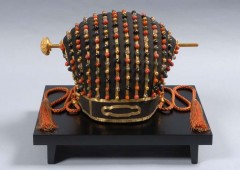2012.09.15
Tens of thousands protest Osprey deployment
Ginowan Seaside Park and a space outside the Diet building in Tokyo on Sunday were the venues for tens of thousands who gathered to voice their opposition to deployment of U.S. Osprey military aircraft to Futenma Marine Corps Air Station.
Protesters demanded the United States and Japan immediately scrap plans to deploy 12 MV-22 Ospreys at Futenma, and shut down the Futenma base in the crowded city of Ginowan. “We refuse to accept a deployment of Osprey that has already proven so dangerous,” said Ginowan Mayor Atsushi Sakima. “Who is going to take responsibility if they crash onto a populated neighborhood?”
The turnout at the main rally was estimated by organizers at more than 100,000, but Okinawan media put the number at “tens of thousands.” “We don’t want the Osprey, the world’s most dangerous aircraft” read a placard at the mass rally at a seaside park near the base, according to television footage. “Osprey. No!” said another. Similar rallies were staged on two smaller is
lands in the Okinawa island chain, and in Tokyo several thousand people circled the Diet building.
The Osprey has rotors that allow it to take off like a helicopter. It can refuel in the air, allowing it to cover big distances in a region where concerns have mounted over the rise of China. Ginowan mayor Atsushi Sakima told the rally the safety of the hybrid transport aircraft “has not been guaranteed.”
In April, an MV-22 Osprey crashed in Morocco, killing two Marines. The official investigation report ruled out problems with the aircraft, attributing the crash to pilot error. Another variant of the aircraft crashed in June in Florida, injuring five crew members. U.S. officials said the accident was also caused by pilot error, and was not due to mechanical problems.
Prime Minister Yoshihiko Noda told U.S. Secretary of State Hillary Clinton of Japan’s concerns over the Osprey’s safety on the sidelines of an Asia-Pacific summit in Russia on Saturday, according to Japanese media. The United States and Japan have been bogged down for years in talks to relocate Futenma, which locals want to see moved away from the island chain.
The rally was attended by Japanese ruling party and opposition lawmakers as well as heads or other senior officials from all 41 municipalities in Okinawa. Meanwhile, Okinawa Governor Hirokazu Nakaima, who remains opposed to the Osprey deployment plan, did not take part, saying that his action as administrative head of Okinawa should be differentiated slightly from citizens’ movement.
The rally organizers are slated to visit Tokyo today to deliver the resolution to Japanese Defense Minister Satoshi Morimoto and Foreign Minister Koichiro Genba. They are also considering visiting the United States in October to lodge Okinawa’s protest against the Osprey deployment plan directly to the U.S. government.
A total of 12 MV-22 Osprey planes were transported to Iwakuni Marine Corps Air Station in Yamaguchi Prefecture, western Japan, in late July ahead of their deployment to Futenma. The U.S. Defense Department hopes to start operations of the 12 Ospreys in Okinawa in October.
Delivering a speech at the protest rally, Ayumi Kajiku, a 21-year-old student at Okinawa International University, which is located adjacent to the MCAS Futenma, said the Osprey should never be deployed in Okinawa. She said: “Okinawa’s blue sky is for neither the United States nor the Japanese government. It’s for the people of Okinawa. I do not want to imagine a future where children live while being exposed to danger,” Kajiku said.
“The Japanese and U.S. governments have been saying the Osprey is safe, but their explanations are not convincing,” Kajiku told reporters. “The aircraft is too dangerous,” she said. While noting that many young people appear to be indifferent to problems related to U.S. bases, Kajiku said she hopes many people will start thinking about the base issues through the latest event.
In August 2004, a helicopter belonging to the Futenma base crashed into the premises of Okinawa International University, injuring three crew members on board. Hiromasa Iha, a 59-year-old company employee, said that if an Osprey crash happens, it would certainly cause catastrophic results.
In 1959 when Okinawa was still under U.S. occupation, a U.S. F-100 fighter jet crashed into a local elementary school, killing a total of 17 people including 11 students. Iha was a first grader at the school when the accident occurred.

 2024.07.07
2024.07.07 2024.07.02
2024.07.02 2024.06.11
2024.06.11 2024.06.03
2024.06.03 2024.05.02
2024.05.02 2024.04.26
2024.04.26 2024.04.04
2024.04.04 2024.04.02
2024.04.02 2024.03.03
2024.03.03 2024.02.26
2024.02.26






